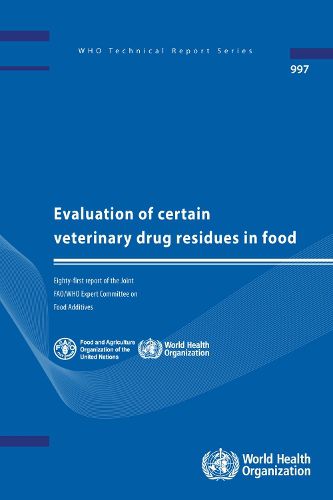Readings Newsletter
Become a Readings Member to make your shopping experience even easier.
Sign in or sign up for free!
You’re not far away from qualifying for FREE standard shipping within Australia
You’ve qualified for FREE standard shipping within Australia
The cart is loading…






This report represents the conclusions of a Joint FAO/WHO Expert Committee convened to evaluate the safety of residues of certain veterinary drugs in food and to recommend maximum levels for such residues in food. The first part of the report considers general principles regarding the evaluation of residues of veterinary drugs within the terms of reference of the Joint FAO/WHO Expert Committee on Food Additives (JECFA), including MRLs for generic fish species, acute reference doses (ARfDs) for veterinary drugs, an approach for dietary exposure assessment of compounds used for multiple purposes (i.e. veterinary drugs and pesticides), dietary exposure assessment for less-than-lifetime exposure, and the assessment of short-term (90-day and 12-month) studies in dogs. Summaries follow of the Committee’s evaluations of toxicological and residue data on a variety of veterinary drugs: two insecticides (diflubenzuron and teflubenzuron), an antiparasitic agent (ivermectin), an ectoparasiticide (sisapronil) and a 2-adrenoceptor agonist (zilpaterol hydrochloride). In addition, the Committee considered issues raised in concern forms from the Codex Committee on Residues of Veterinary Drugs in Foods on lasalocid sodium, an antiparasitic agent. Annexed to the report is a summary of the Committee’s recommendations on these drugs, including acceptable daily intakes (ADIs), ARfDs and proposed MRLs.
$9.00 standard shipping within Australia
FREE standard shipping within Australia for orders over $100.00
Express & International shipping calculated at checkout
This report represents the conclusions of a Joint FAO/WHO Expert Committee convened to evaluate the safety of residues of certain veterinary drugs in food and to recommend maximum levels for such residues in food. The first part of the report considers general principles regarding the evaluation of residues of veterinary drugs within the terms of reference of the Joint FAO/WHO Expert Committee on Food Additives (JECFA), including MRLs for generic fish species, acute reference doses (ARfDs) for veterinary drugs, an approach for dietary exposure assessment of compounds used for multiple purposes (i.e. veterinary drugs and pesticides), dietary exposure assessment for less-than-lifetime exposure, and the assessment of short-term (90-day and 12-month) studies in dogs. Summaries follow of the Committee’s evaluations of toxicological and residue data on a variety of veterinary drugs: two insecticides (diflubenzuron and teflubenzuron), an antiparasitic agent (ivermectin), an ectoparasiticide (sisapronil) and a 2-adrenoceptor agonist (zilpaterol hydrochloride). In addition, the Committee considered issues raised in concern forms from the Codex Committee on Residues of Veterinary Drugs in Foods on lasalocid sodium, an antiparasitic agent. Annexed to the report is a summary of the Committee’s recommendations on these drugs, including acceptable daily intakes (ADIs), ARfDs and proposed MRLs.